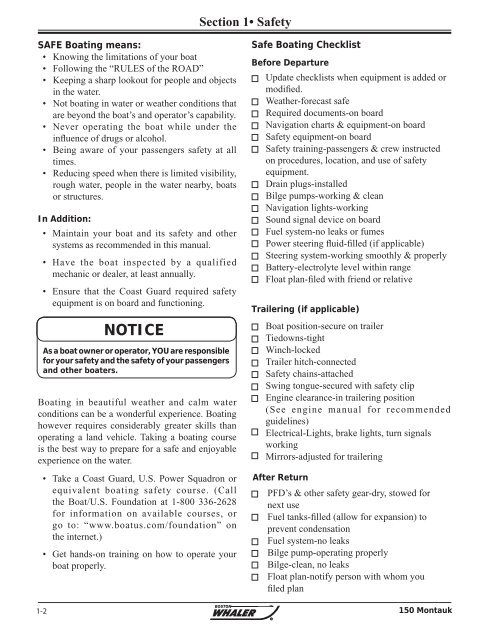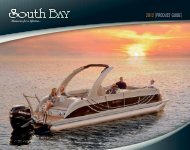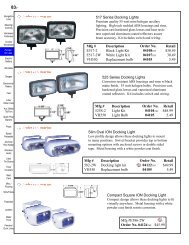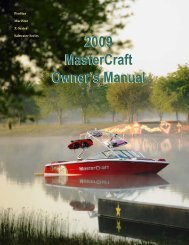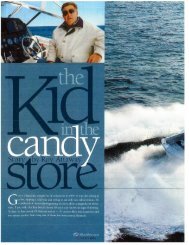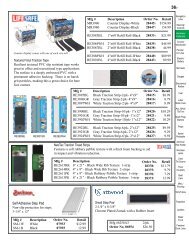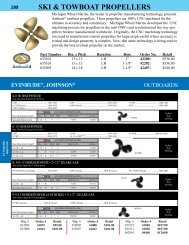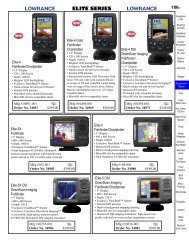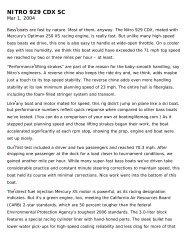notice - Boston Whaler
notice - Boston Whaler
notice - Boston Whaler
Create successful ePaper yourself
Turn your PDF publications into a flip-book with our unique Google optimized e-Paper software.
SAFE Boating means:<br />
• Knowing the limitations of your boat<br />
• Following the “RULES of the ROAD”<br />
• Keeping a sharp lookout for people and objects<br />
in the water.<br />
• Not boating in water or weather conditions that<br />
are beyond the boat’s and operator’s capability.<br />
• Never operating the boat while under the<br />
infl uence of drugs or alcohol.<br />
• Being aware of your passengers safety at all<br />
times.<br />
• Reducing speed when there is limited visibility,<br />
rough water, people in the water nearby, boats<br />
or structures.<br />
In Addition:<br />
• Maintain your boat and its safety and other<br />
systems as recommended in this manual.<br />
• Have the boat inspected by a qualified<br />
mechanic or dealer, at least annually.<br />
• Ensure that the Coast Guard required safety<br />
equipment is on board and functioning.<br />
NOTICE<br />
As a boat owner or operator, YOU are responsible<br />
for your safety and the safety of your passengers<br />
and other boaters.<br />
Boating in beautiful weather and calm water<br />
conditions can be a wonderful experience. Boating<br />
however requires considerably greater skills than<br />
operating a land vehicle. Taking a boating course<br />
is the best way to prepare for a safe and enjoyable<br />
experience on the water.<br />
• Take a Coast Guard, U.S. Power Squadron or<br />
equivalent boating safety course. (Call<br />
the Boat/U.S. Foundation at 1-800 336-2628<br />
for information on available courses, or<br />
go to: “www.boatus.com/foundation” on<br />
the internet.)<br />
• Get hands-on training on how to operate your<br />
boat properly.<br />
Section 1• Safety<br />
Safe Boating Checklist<br />
Before Departure<br />
Update checklists when equipment is added or<br />
modifi ed.<br />
Weather-forecast safe<br />
Required documents-on board<br />
Navigation charts & equipment-on board<br />
Safety equipment-on board<br />
Safety training-passengers & crew instructed<br />
on procedures, location, and use of safety<br />
equipment.<br />
Drain plugs-installed<br />
Bilge pumps-working & clean<br />
Navigation lights-working<br />
Sound signal device on board<br />
Fuel system-no leaks or fumes<br />
Power steering fl uid-fi lled (if applicable)<br />
Steering system-working smoothly & properly<br />
Battery-electrolyte level within range<br />
Float plan-fi led with friend or relative<br />
Trailering (if applicable)<br />
Boat position-secure on trailer<br />
Tiedowns-tight<br />
Winch-locked<br />
Trailer hitch-connected<br />
Safety chains-attached<br />
Swing tongue-secured with safety clip<br />
Engine clearance-in trailering position<br />
(See engine manual for recommended<br />
guidelines)<br />
Electrical-Lights, brake lights, turn signals<br />
working<br />
Mirrors-adjusted for trailering<br />
After Return<br />
PFD’s & other safety gear-dry, stowed for<br />
next use<br />
Fuel tanks-fi lled (allow for expansion) to<br />
prevent condensation<br />
Fuel system-no leaks<br />
Bilge pump-operating properly<br />
Bilge-clean, no leaks<br />
Float plan-notify person with whom you<br />
fi led plan<br />
1-2 150 Montauk<br />
R


